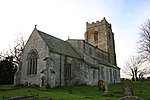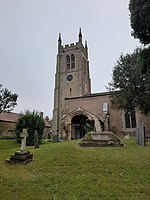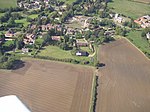Sempringham is a village in the civil parish of Pointon and Sempringham, in the South Kesteven district of Lincolnshire, England. It is situated 2 miles (3.2 km) south from the A52 road, 12 miles (19 km) east from Grantham and 8 miles (13 km) north from Bourne. The hamlet is on the western edge of the Lincolnshire Fens, the closest village being Billingborough, 0.5 miles (0.80 km) to the north on the B1177 road. Sempringham is noted as the home of Gilbert of Sempringham, the son of the lord of the manor. Gilbert is the only English Saint to have founded a monastic order, the Gilbertines. In 1921 the parish had a population of 112. On 1 April 1931 the parish was abolished to form "Pointon and Sempringham".Sempringham consists of a church and a holy well, with other houses east from the church scattered along the B1177 between Pointon and Billingborough. The church stands at an altitude of about 52 feet (16 m), on land rising out of flat fenland. Pointon is the chief township of the civil parish, which includes Millthorpe and the fens of Pointon, Neslam and Aslackby, and a part of Hundred Fen at Gosberton Clough. Formerly, Birthorpe, now part of Billingborough, was included in the parish.
The parish church is a Grade I listed building, dedicated to Saint Andrew and dating from 1170. It was restored and the chancel rebuilt in 1868-69 by Edward Browning.Sempringham is noted in the Domesday account as "Stepingeham" in the Aveland Hundred of Kesteven. In 1086 the manor consisted of 35 households, 8 villagers, 2 smallholders and 14 freemen, with 4.3 ploughlands, a meadow of 11 acres (0.045 km2) and woodland of 7 acres (0.028 km2). In 1066 Earl Morcar was Lord of the Manor, which was transferred to Jocelyn, son of Lambert in 1086, with Tenant-in-chief as Alfred of Lincoln.In the early 17th century, Sempringham was a centre of the Puritan movement in Lincolnshire. Samuel Skelton, curate of Sempringham, sailed to Massachusetts Bay in 1628 with the first group of Puritan settlers, who landed in Salem. Another member of the Sempringham congregation at the time was the young Anne Dudley, later Anne Bradstreet, the colony's first published poet.











